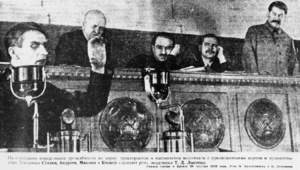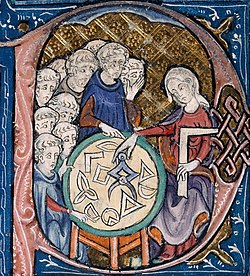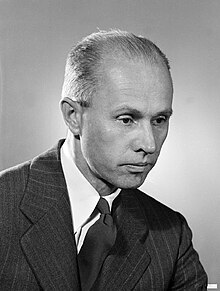The History of Science Portal
The history of science covers the development of science from ancient times to the present. It encompasses all three major branches of science: natural, social, and formal. Protoscience, early sciences, and natural philosophies such as alchemy and astrology during the Bronze Age, Iron Age, classical antiquity, and the Middle Ages declined during the early modern period after the establishment of formal disciplines of science in the Age of Enlightenment.
Science's earliest roots can be traced to Ancient Egypt and Mesopotamia around 3000 to 1200 BCE. These civilizations' contributions to mathematics, astronomy, and medicine influenced later Greek natural philosophy of classical antiquity, wherein formal attempts were made to provide explanations of events in the physical world based on natural causes. After the fall of the Western Roman Empire, knowledge of Greek conceptions of the world deteriorated in Latin-speaking Western Europe during the early centuries (400 to 1000 CE) of the Middle Ages, but continued to thrive in the Greek-speaking Byzantine Empire. Aided by translations of Greek texts, the Hellenistic worldview was preserved and absorbed into the Arabic-speaking Muslim world during the Islamic Golden Age. The recovery and assimilation of Greek works and Islamic inquiries into Western Europe from the 10th to 13th century revived the learning of natural philosophy in the West. Traditions of early science were also developed in ancient India and separately in ancient China, the Chinese model having influenced Vietnam, Korea and Japan before Western exploration. Among the Pre-Columbian peoples of Mesoamerica, the Zapotec civilization established their first known traditions of astronomy and mathematics for producing calendars, followed by other civilizations such as the Maya.
Natural philosophy was transformed during the Scientific Revolution in 16th- to 17th-century Europe, as new ideas and discoveries departed from previous Greek conceptions and traditions. The New Science that emerged was more mechanistic in its worldview, more integrated with mathematics, and more reliable and open as its knowledge was based on a newly defined scientific method. More "revolutions" in subsequent centuries soon followed. The chemical revolution of the 18th century, for instance, introduced new quantitative methods and measurements for chemistry. In the 19th century, new perspectives regarding the conservation of energy, age of Earth, and evolution came into focus. And in the 20th century, new discoveries in genetics and physics laid the foundations for new sub disciplines such as molecular biology and particle physics. Moreover, industrial and military concerns as well as the increasing complexity of new research endeavors ushered in the era of "big science," particularly after World War II. (Full article...)
Selected article -

Lysenkoism (Russian: Лысенковщина, romanized: Lysenkovshchina, IPA: [lɨˈsɛnkəfɕːʲɪnə]; Ukrainian: лисенківщина, romanized: lysenkivščyna, IPA: [lɪˈsɛnkiu̯ʃtʃɪnɐ]) was a political campaign led by Soviet biologist Trofim Lysenko against genetics and science-based agriculture in the mid-20th century, rejecting natural selection in favour of a form of Lamarckism, as well as expanding upon the techniques of vernalization and grafting.
More than 3,000 mainstream biologists were dismissed or imprisoned, and numerous scientists were executed in the Soviet campaign to suppress scientific opponents. The president of the Soviet Agriculture Academy, Nikolai Vavilov, who had been Lysenko's mentor, but later denounced him, was sent to prison and died there, while Soviet genetics research was effectively destroyed. Research and teaching in the fields of neurophysiology, cell biology, and many other biological disciplines were harmed or banned. (Full article...)Selected image

In this detail from an early 14th century copy of Euclid's Elements, a woman is shown teaching geometry. It is a detail of a scene in the bowl of the letter 'P'; the woman, with a set-square and dividers, uses a compass to measure distances on a diagram. In her left hand she holds a square, an implement for testing or drawing right angles. She is watched by a group of students. In images from the Middle Ages, it is unusual to see women represented as teachers, in particular when the students appear to be monks. She may be the personification of Geometry.
Did you know
...that the travel narrative The Malay Archipelago, by biologist Alfred Russel Wallace, was used by the novelist Joseph Conrad as a source for his novel Lord Jim?
...that the seventeenth century philosophers René Descartes, Baruch Spinoza, and Gottfried Leibniz, along with their Empiricist contemporary Thomas Hobbes all formulated definitions of conatus, an innate inclination of a thing to continue to exist and enhance itself?
...that according to the controversial Hockney-Falco thesis, the rise of realism in Renaissance art, such as Jan Van Eyck's Arnolfini Portrait (pictured), was largely due to the use of curved mirrors and other optical aids?
Selected Biography -
George Bogdanovich Kistiakowsky (Russian: Георгий Богданович Кистяковский, Ukrainian: Георгій Богданович Кістяківський, romanized: Heorhii Bohdanovych Kistiakivskyi; December 1 [O.S. November 18] 1900 – December 7, 1982) was a Ukrainian-American physical chemistry professor at Harvard who participated in the Manhattan Project and later served as President Dwight D. Eisenhower's Science Advisor.
Born in Boyarka in the old Russian Empire, into "an old Ukrainian Cossack family which was part of the intellectual elite in pre-revolutionary Russia", Kistiakowsky fled his homeland during the Russian Civil War. He made his way to Germany, where he earned his PhD in physical chemistry under the supervision of Max Bodenstein at the University of Berlin. He emigrated to the United States in 1926, where he joined the faculty of Harvard University in 1930, and became a citizen in 1933. (Full article...)Selected anniversaries
- 1633 - Birth of Geminiano Montanari, Italian astronomer (d. 1687)
- 1795 - Death of Pierre-Joseph Desault, French anatomist and surgeon (b. 1744)
- 1796 - Birth of Nicolas Léonard Sadi Carnot, French mathematician (d. 1832)
- 1833 - James Clark Ross discovers the position of the North Magnetic Pole on the Boothia Peninsula.
- 1846 - Urbain Le Verrier predicts the existence and location of Neptune from irregularities in the orbit of Uranus.
- 1899 - Birth of Edward Charles Titchmarsh, English mathematician (d. 1963)
- 1917 - Birth of William S. Knowles, American chemist and Nobel Prize laureate
- 1940 - Birth of Kip Thorne, American physicist
- 1941 - Death of Hans Berger, German neuroscientist (b. 1873)
- 1978 - The first international applications under the Patent Cooperation Treaty are filed.
- 1979 - Death of Werner Forssmann, German physician and Nobel Prize laureate (b. 1904)
- 1990 - U.S. President George H. W. Bush and Soviet Union leader Mikhail Gorbachev sign a treaty to end chemical weapon production and start destroying each of their nation's stockpiles.
- 2000 - The multilateral Patent Law Treaty (PLT) is signed.
- 2006 - The first Under Secretary for Science of the US, Raymond L. Orbach, is sworn in.
Related portals
Topics
General images
Subcategories
Things you can do
Help out by participating in the History of Science Wikiproject (which also coordinates the histories of medicine, technology and philosophy of science) or join the discussion.
Associated Wikimedia
The following Wikimedia Foundation sister projects provide more on this subject:
-
Commons
Free media repository -
Wikibooks
Free textbooks and manuals -
Wikidata
Free knowledge base -
Wikinews
Free-content news -
Wikiquote
Collection of quotations -
Wikisource
Free-content library -
Wikiversity
Free learning tools -
Wiktionary
Dictionary and thesaurus








































































